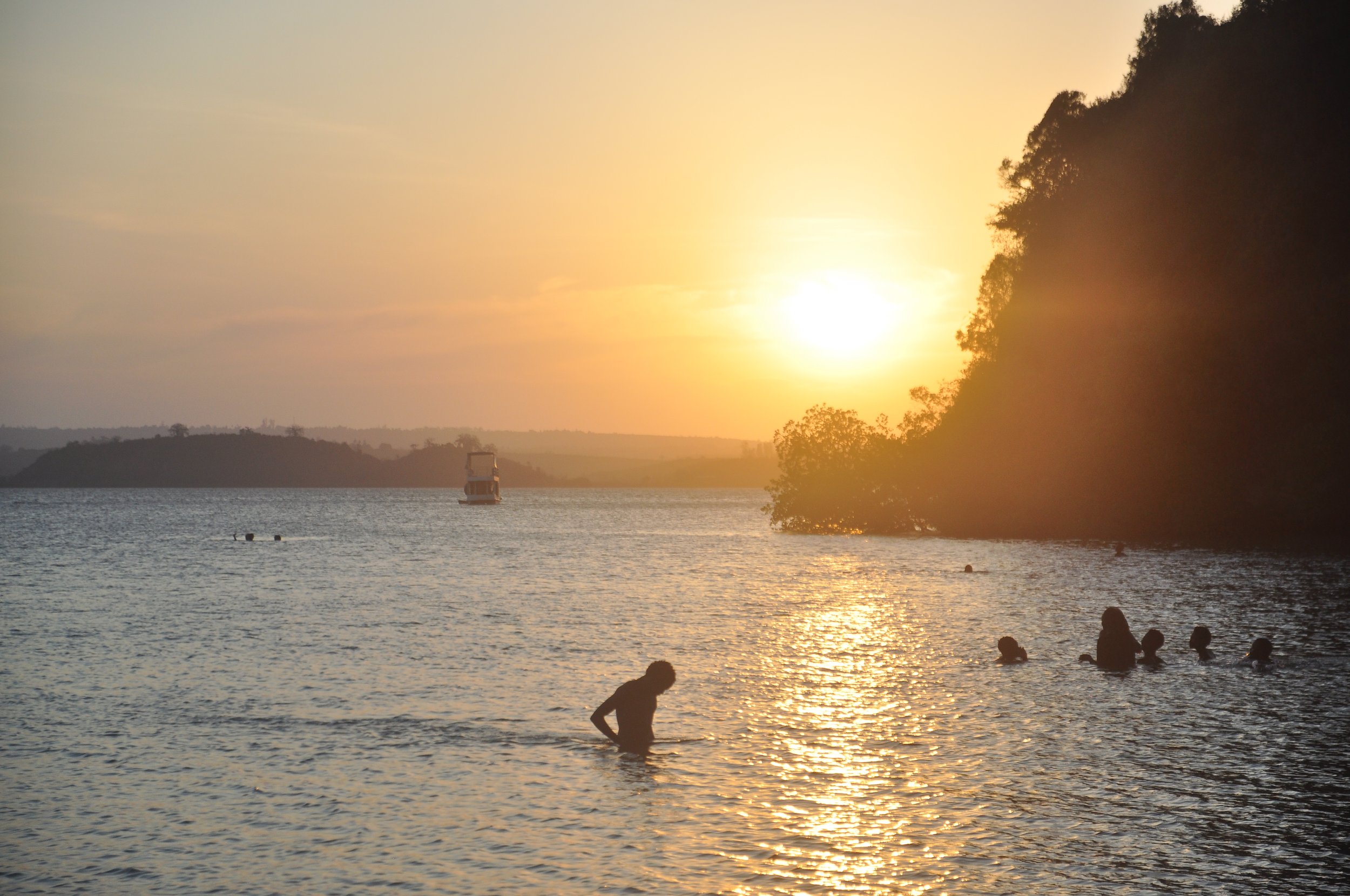Kenya Exploration Part 1: Nairobi to Kilifi
A good night’s sleep after the long journey helps to reset the clock. Along with our board member Dan Berman, I spent two weeks exploring Kenya’s coast and national parks, visiting our many partners in the country and scouting out what will be our first conservation tour outside of the Western Hemisphere.
Brad, Dan, and Joe from Ocean Sole
This morning, our first activity is to visit Ocean Soles’ facility outside of Nairobi. This impressive organization recycles hundreds of thousands of flip flops each year into incredible artwork including life-size elephants, turtles, and many more animals. This art employs more than 20 Nairobi-based artists along with local women’s groups along the coast who conduct the cleanups. We then head to Tamarind, a lovely restaurant on a large campus with our own private gazebo in a forest setting.
We then take a short flight to Diani to meet with our long-time friend and colleague Joana Hancock, a biologist that I worked with early in my career in Costa Rica who has been working for Olive Ridley Project for the past several years. Joana joined us for the coastal portion of the journey. Olive Ridley Project works to study and protect the turtles living in the reefs along one of the country’s most beautiful beaches. While the spring tides didn’t allow us to look for turtles on this visit, we enjoyed a leisurely canoe ride with a local fisherman on the creek before dinner at a lovely beachside restaurant.
Joana and Dan on our sunset canoe ride
Our morning started with a lesson on local primates with a visit to the Colubus Conservation. Approaching the entrance, we made space for a baboon using our side of the street and then headed down a dirt road to the facility. This organization does research, rehabilitation, and education on the area’s four primate species, Colubus, Vervets, Sykes Monkeys, and Baboons. As we started our tour, a local school group returned from their visit giddy with excitement from learning about these fascinating animals. The center helps to rehabilitate injured monkeys and release them to the wild as well as selling native plants to local landowners to restore their habitat. The end of the tour treated us to multiple trees filled with families of Colubus monkeys lazily resting across a large tree.
Colubus Monkeys in Diani Beach
We followed that with breakfast at a wonderful restaurant called the Pallet Café which employs and supports hearing impaired local residents, on a gorgeous stretch of beach. We learned about the hundreds of green turtles that ORP has cataloged in this reef and the threats they face, including accidental capture in fishing gear, illegal hunting, and destructive development projects.
Our next stop is Mombasa, the country’s second largest city and former capital, an hour’s drive north up the coast. We visited a local spice market, sampling several different fruits and street foods and buying some of the country’s great coffee and masala chai, with the help of some new local friends. From there, we continued on to our next stop on the coast, Kilifi. We checked into our rooms for the night at Distant Relatives Ecolodge, one of the most sustainable hotels I’ve ever stayed in, including using natural materials, composting toilets (that don’t smell), and supporting local mangrove reforestation efforts. We made our way down the hill from the lodge to visit a lovely mangrove and creek to have a drink and watch the sunset. The water was glorious and the birds added a musical soundtrack. We then joined the coastal Ocean Sole team to meet their turtle researchers and Ocean Mamaz who lead local beach cleanup efforts.
Traditional dhow fishing boat
Enjoying the creek at sunset
Regenerating coral at Kuruwitu. Photo: Kuruwitu Conservation
Early that morning, I woke up and wasn’t able to get back to sleep so I decided to head back down to the creek to enjoy a peaceful morning. Accompanied only by plentiful birds and a couple of fishermen, I had a relaxing meditation sitting in a mangrove tree and then a walk through the shallow water to get a better view of the creek and the interesting rock formations. We then had breakfast and a visit to Kuruwitu Marine Reserve, where our fantastic guide Katana took us on a guided snorkel of their impressive community-managed marine protected area.
This 30 hectare reserve was started in 2006 by the local fishing community as a way to help restore fish stocks that have been depleted over the years. In addition to restricting fishing in the reserve, the program is implementing a coral restoration program, having transplanted dozens of samples of several different species in an effort to bring back the reefs that have been damaged by coral bleaching, which happens when the polyps are expelled from the reef when temperatures get too high, one of many impacts of climate change on our oceans. The reserve has many species of fish including tang and parrotfish, as well as sea turtles and other marine life.
This wonderful opportunity to enjoy the water was followed by a mini-symposium organized by Ocean Sole and us, bringing together 11 different conservation organizations and government agencies working to study and protect Kenya’s sea turtles. Most of these organizations have all been partners with either our Billion Baby Turtles, Sea Turtles & Plastic, and Sea Turtle Community Leader programs (and in some cases, more than one). The participants all presented on their work and took questions from the other partners, allowing for opportunities to learn and explore collaboration.
Participating organizations were Ocean Sole, Bahari Hai, Mariners For Action, Local Ocean Conservation, Kenyan Youth Biodiversity Network, Kiunga Turtle Conservation Camp, Olive Ridley Project, Kenyan Youth Biodiversity Network, & Kishoka Youth Organization. Among many highlights were presentations by two of our newest Sea Turtle Community Leaders, Leah Manye of Olive Ridley Project and Nicholas Otieno of Mariners For Action.







